Table of Contents
- The Helpful Content Update penalizes low-quality, paid link sources; therefore, quality, natural backlinks are essential.
- Link count alone is misleading—filter by referring domains, traffic, authority, and link type to assess value.
- Tools like Ahrefs’ “Best Links” and anchor context analysis help isolate impactful, non-syndicated links.
- Industry link benchmarks reveal inflated totals; real competition lies in far fewer, high-quality links.
- Prioritizing link quality helps future-proof rankings and combats the rise of exploitative link schemes.
Update: Since March 2024’s Helpful Content Update, many people have again debated the value of links. So, I decided to update this piece to provide more context.
Now, more than ever, quality links are more important than quantity. Google has put the pedal to the metal by using AI for evaluation. They have SpamBrain out looking for sites that are buying and selling links. So, sites that you once thought were valuable are no longer.
Either way, you’re building links naturally, buying links, or an agency pitching links, you probably don’t need any many links as you think.
Now, I’m no link building saint. I’ve built, begged, bartered, and bought links. But over the years it has always proven that the links with real value are the ones that are built naturally.
If you’re looking for quick wins, then stop reading now. But if you really want the answer to, “how many backlinks do I need” and you care about the longevity of your links and the health of your site, then continue on.

Do You Need Links To Rank?
The answer is definitely yes, but to what degree remains a mystery.
This search traffic study from Ahrefs, among others, shows a positive correlation between the number of referring domains and search traffic.
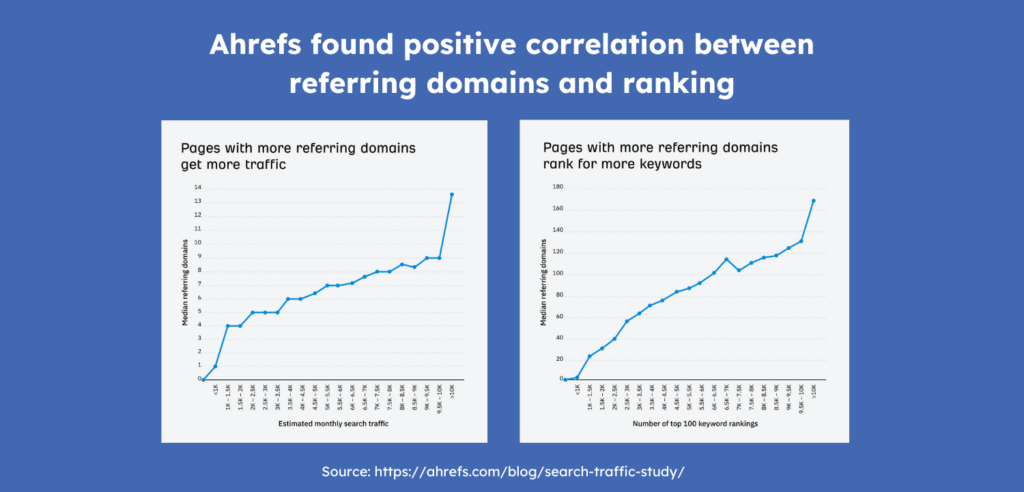
Links certainly aren’t the only ranking factor. In fact, lately, Google has said that links matter less in the grand ranking algorithm.
How Has HCU Impacted Link Building?
If anything, HCU has proven that quality, naturally-built links are even more important.
We’ve seen multiple sites whose main purpose is buying and selling links completely tank after the Helpful Content Algorithm update.
Virtually every day I’m pitched a list of sites where I can “purchase” a link.
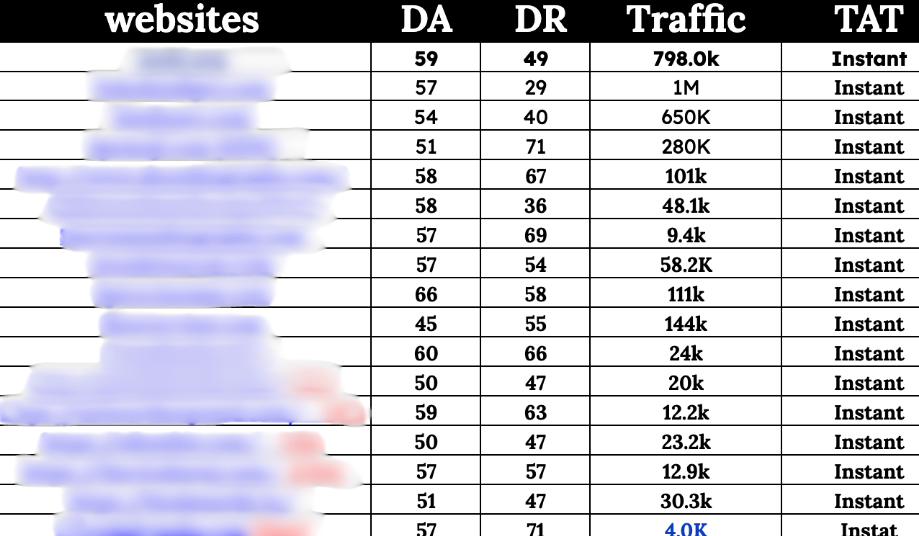
These sites are typically general purpose “news” sites that share a wide variety of topics. They all have a lot of backlinks and relatively higher DR/DA.
But, looking closely at them, you start to see a trend.
Their organic traffic is dropping like crazy. Google has figured out the game. Here’s a tech news site that’s dropped right after the March update.
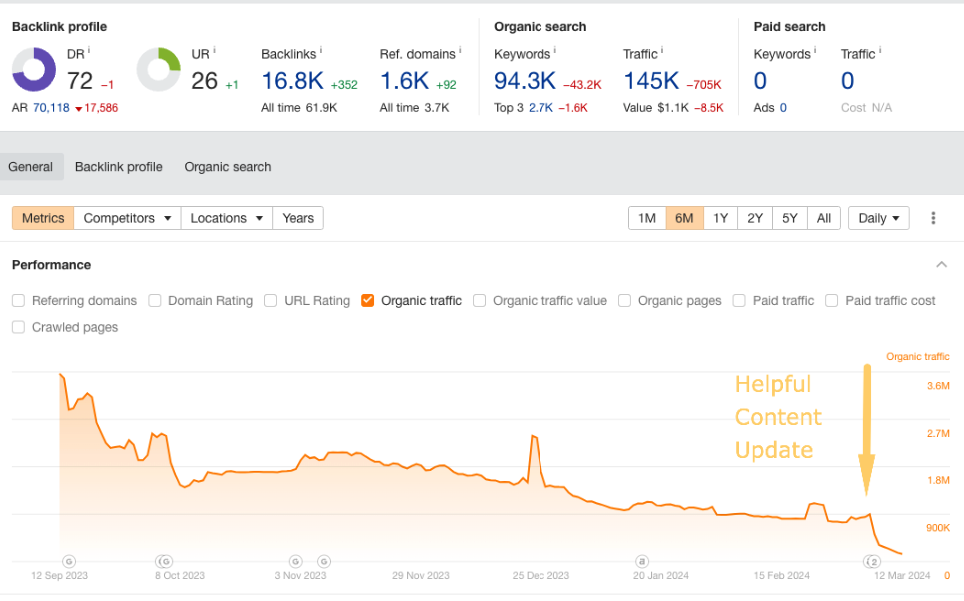
Here’s another:
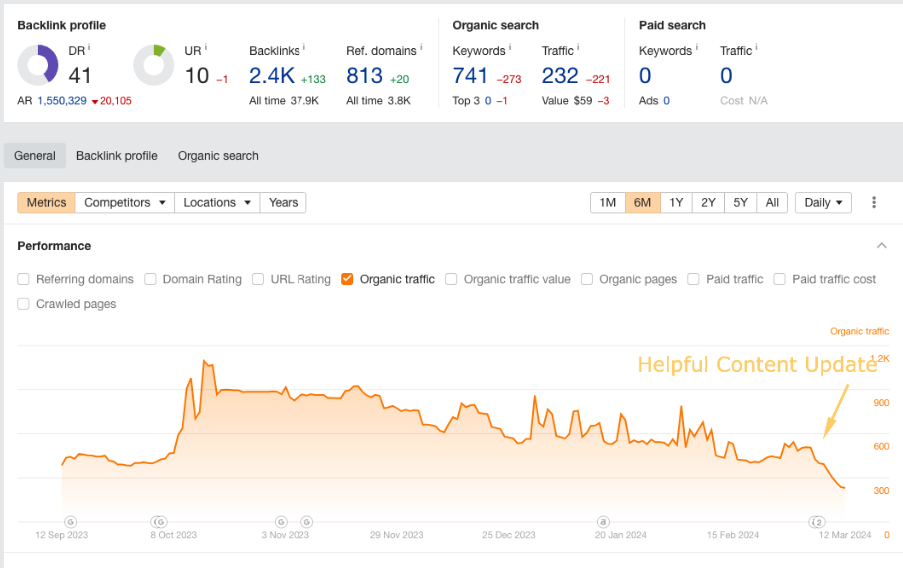
And here’s one that’s been steadily dropping to nothing since the previous Helpful Content Update announcement in 2023:
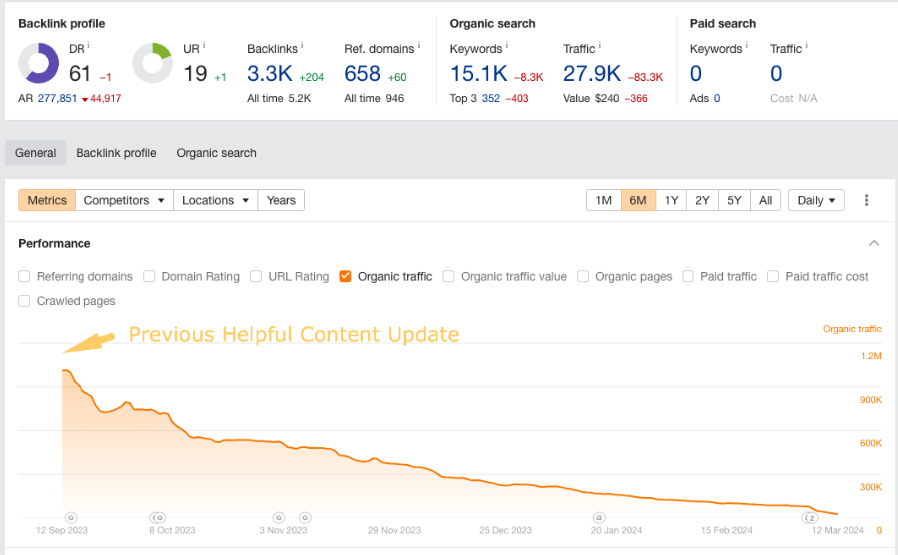
What does this all mean?
It means that the quality of the site you get links from is more important than ever.
How Many Backlinks Do You Need to Build?
The answer is also it depends. If you are building backlinks as more of a brand awareness and PR campaign, then you should build as many quality, relevant links as you can.
If you are building links to rank, the short answer is that you need to build more links than the others.
However, the number of links shown on tools like SEMRush or Ahrefs doesn’t initially reflect the quality of links a page has without a little digging.
So unless you filter when analyzing, you are working off severely inflated metrics.
Whether you want to understand how many links you need to build to outdo competitors for a single term or as part of a sitewide competitive analysis, it’s important to drill down the backlink profiles into more specific quality metrics.
How to Filter for Quality Links in 5 Simple Steps
Here are the steps for uncovering the number of quality links a page or domain has.
1. Focus on Referring Domains, Not Backlinks
First off, focus on the number of referring domains, not backlinks. This is because multiple links from the same website pass less value.
This isn’t to say you should never build links from the same site, but focus on the referring domains for analysis purposes.
2. Filter Out Low DR backlinks
Metrics like Ahref’s Domain Rating and Moz’s Domain Authority estimate your ability to rank. To uncover quality backlinks, you should filter out the duds. (It’s important to note that not all low DR/DA sites are poor. Some may be highly relevant, brand-new sites that need time to grow. If you are confident in the link’s long-term value, go for it.)
3. Filter Out Backlinks From Low Traffic Sites
By filtering out backlinks from sites with low organic traffic, you’ll eliminate those with low-quality backlink profiles.
4. Filter Out Nofollow Links
If you build links for ranking purposes, dofollow links pass SEO value, whereas nofollow links do not.
Nofollow links from large publications and high-traffic sites are great for brand recognition and potentially bring traffic to your site. Still, technically, a nofollow link does not pass SEO value.
Tinfoil hat SEOs may disagree (though they have been shot down by Google).
You can do the steps 2-4 using Ahrefs’ Best links feature.
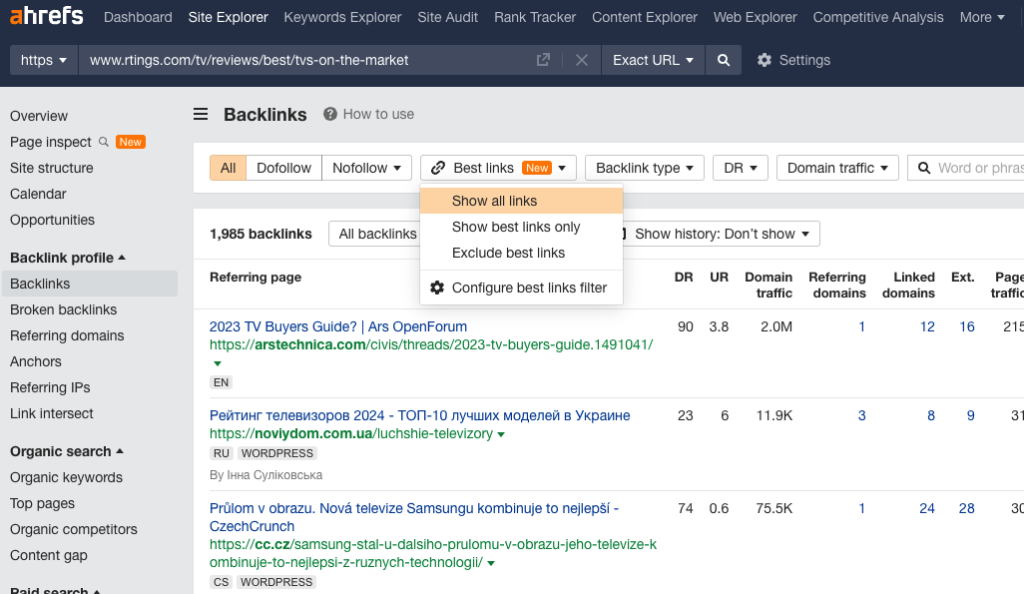
Simply toggle on the filter to Show best links only and it will cull the list.
5. Filter Out the Syndicated Content
The last piece here is filtering out syndicated content. Don’t get me wrong, getting your content syndicated is great for brand and potential traffic. Hypothetically, it could lead to other people seeing your content and republishing the original content.
However, as well-documented research from SEO agency Reboot shows, the potential SEO value from syndication is likely minimal. It is duplicate content and is supposed to canonicalize to the original content (meaning it should only pass value from the initial site).
Syndicated content can easily be spotted using when looking at anchor
If we look for duplicate content surrounding the anchor text, its a quick signal that these are syndicated links.
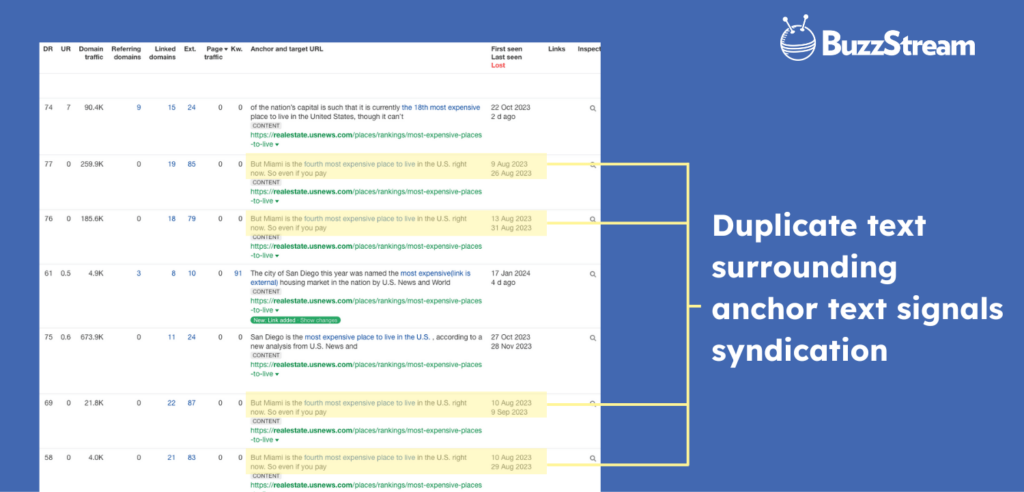
So, with those five steps in mind, let’s look at three key examples.
Three Examples of Link Quality vs Quantity
Below I’ll break down three examples where link quantity on the surface is not what it seems.
Example one: Best TV’s
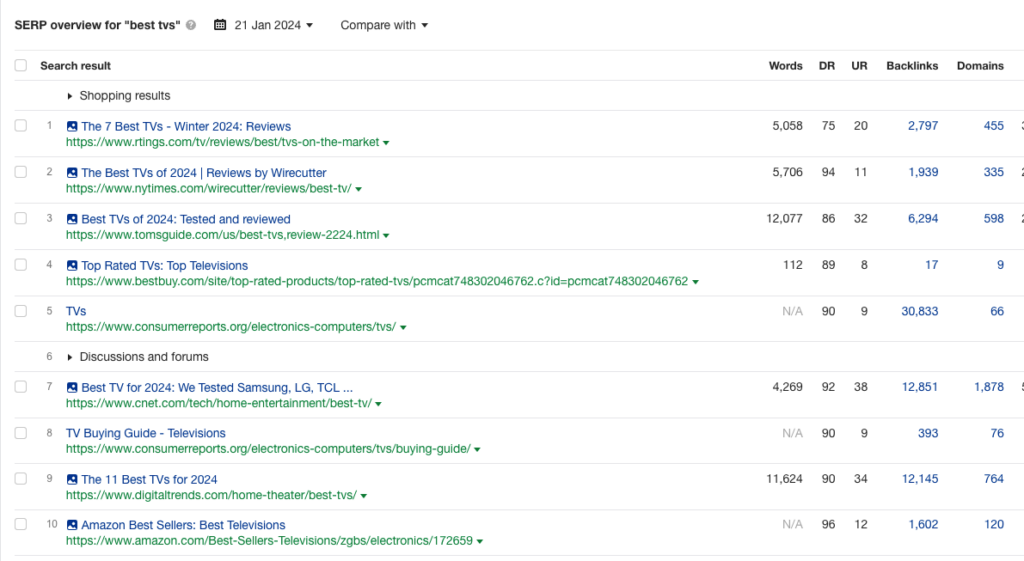
Why is rtings.com beating out Cnet even though Cnet has a higher DR and link count?
Let’s dig into the backlinks for rtings.com. Then, if we set it to one link per domain, we are effectively looking at the linking root domains:
We see it starts at 356 unique referring domains.
We can filter manually, but let’s filter using Ahref’s new Best Links feature, consolidating some of the manual work. (This feature was surreptitiously released after I recorded the video accompanying this post — so I had to return to the studio quickly.)
With the Best Links feature, we set this to the following metrics: all links are dofollow, must have DR above 25, and the site should have more than 1,500 organic visits per month:
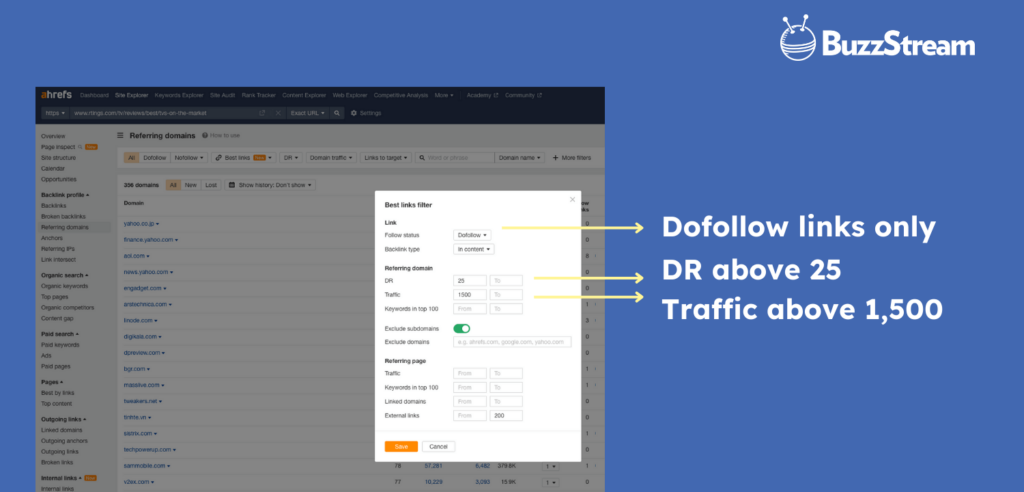
The total jumps from 356 down to 16 links.
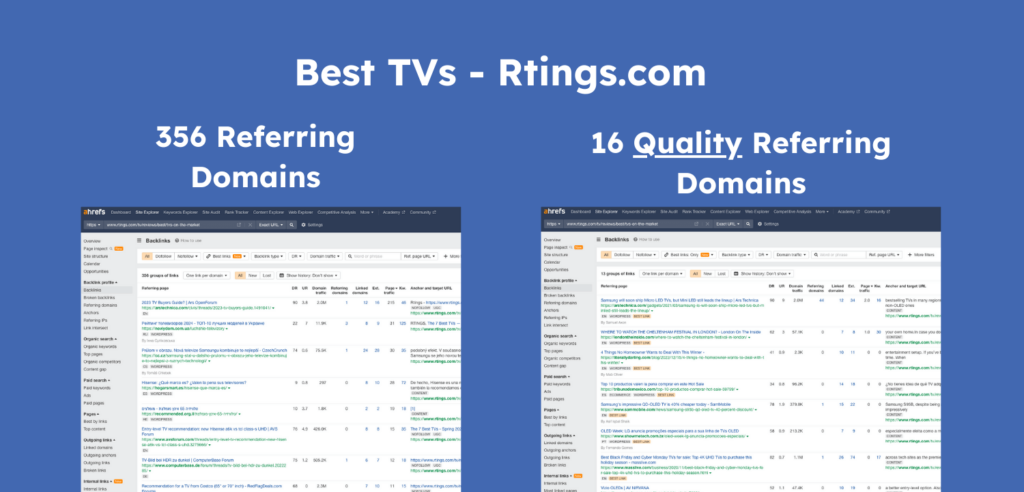
Now let’s compare to Cnet.
On the surface, they have 1,599 unique linking domains. After filtering down, we see 69 unique linking domains.
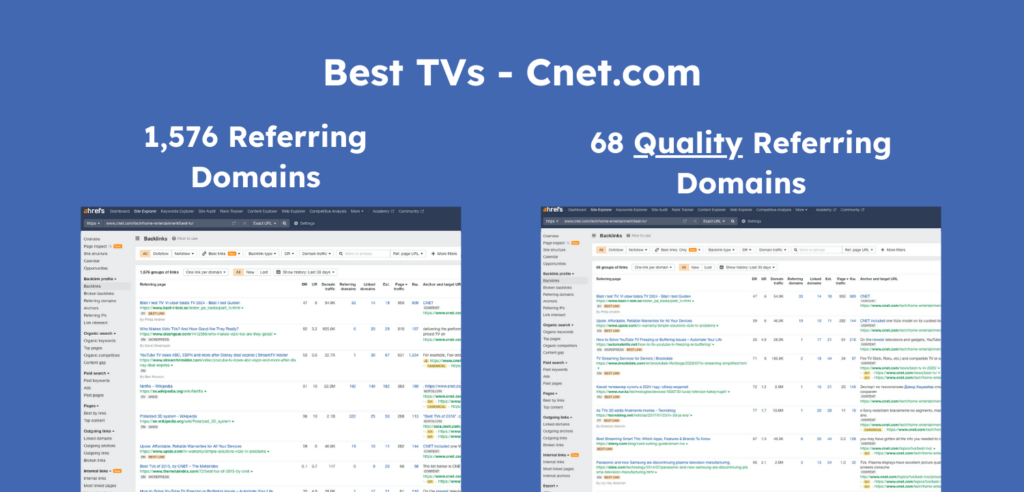
Although this may be where you thought I was headed, the answer to why rtings.com is beating out Cnet isn’t because one has more quality backlinks.
There is always more to the story than only looking at links when talking about ranking—freshness, anchor text usage, keywords on a page, etc, all play a part.
Nevertheless, if you are setting out to compete through link building, this approach gives you a much more realistic target.
Example 2: Most Expensive Cities In The US
Let’s look at a keyword where ranking posts garner news coverage.
US News ranks first for “most expensive cities in the US” with 405 linking root domains.
When filtering for the best links, we see 98 linking root domains.
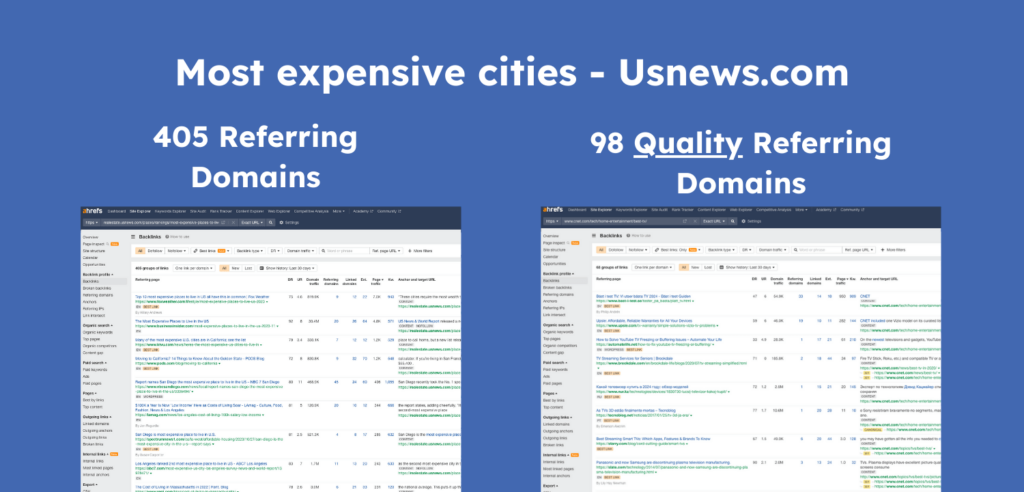
But in this case, we also see syndicated links come into play.
So, I’ve exported this list into a Google Sheet to see the text surrounding anchor. I’ve highlighted the left context column.
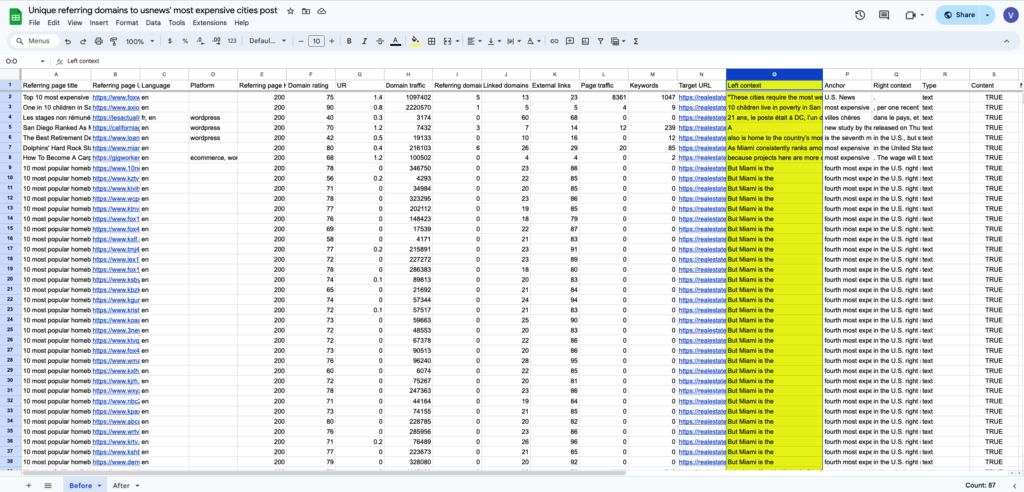
After removing duplicates for the text surrounding the anchor text, we find that we are left with 41 unique referring domains that pass link value.
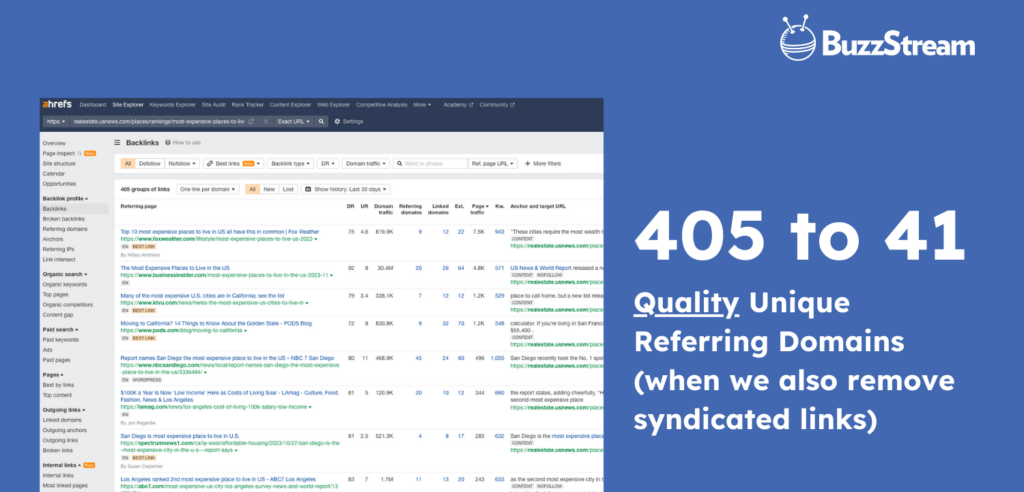
Important to reiterate that syndicated links are not a bad thing. They just won’t pass the same link value, so when evaluating, you should consider removing them.
Example 3: Head-to-Head Competition
You can use this approach at the keyword level, or if you are just starting your link building campaigns and want to know how many links you need to outdo the competition, you can try this as a head-to-head approach.
Say we were a Mailchimp competitor, and we wanted to know how many links we should build to stay competitive.
For this, we can use Ahrefs Site Explorer.
Mailchimp has over 325,000 referring domains.
We can look at referring domains and use the Best Links Only filter to see that really there are only 19,991 quality referring domains.
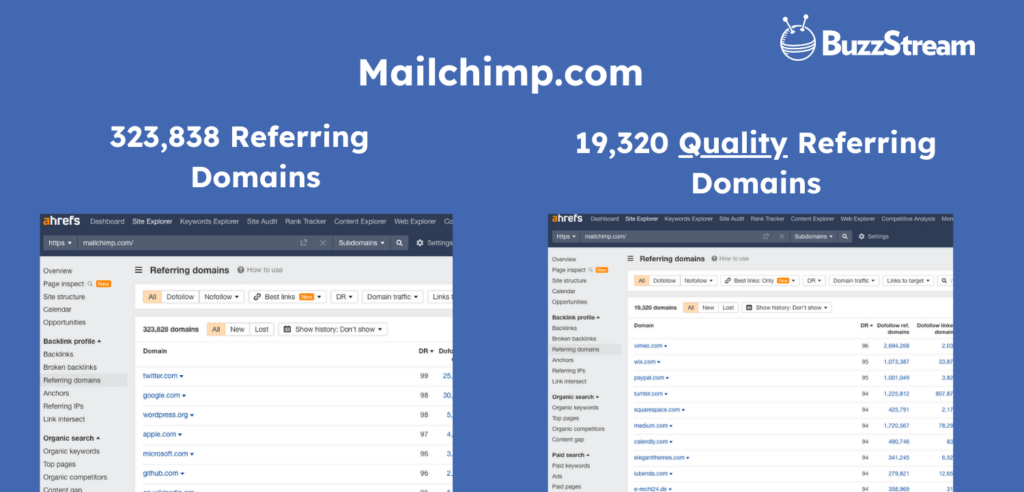
19,000 is still a high number, but considerably less than 325,000.
The Industry Impact of Focusing On Quality Backlinks vs Quantity
I want to make sure that I point out that links aren’t the only ranking factor. Google has said that they may matter less than they once did. So, several other factors need to coalesce to rank well.
However, I believe that one of the reasons Google keeps adjusting the value of links is to combat the proliferation of black hat and grey hat methods that have pushed quantity over quality. If we don’t stick to white hat link building focused on quality, a vicious cycle starts.
The more links we feel we need to build, the more pressure it puts on agencies and in-house teams to hit link goals without focusing on quality, and the more predatory link farms continue to try to exploit ranking factors.
Ultimately, what we’re trying to do as link builders at the end of the day is to build natural, quality, relevant links.
The more that we can do that and the more we can focus on quality and not quantity, I think the better off we’ll be as an industry at large.

 End-to-end outreach workflow
End-to-end outreach workflow



 Check out the BuzzStream Podcast
Check out the BuzzStream Podcast







